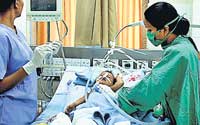
Operation Saving Nipuna~ Doctors at Lady Ridgeway Hospital recently performed pioneering heart surgery to save a 13-day-old baby. The tiny babe's eyes are wide open. He puckers up his face and opens his mouth in a wide yawn. What 18-day-old Nipuna Nethranjana Tennekoon, tenderly being cradled in the arms of a nurse of the Lady Ridgeway Hospital in Colombo, is oblivious to is that he is a trailblazer in the state health sector. For at just 13 days, he went under the scalpel, for open heart surgery to correct the wrong positioning of two major vessels bringing in and taking out blood from his tiny heart.
Calling it a "complicated and meticulous" procedure to correct the Transposition of the Great Arteries, Consultant Cardiothoracic Surgeon Dr. Gamini Ranasinghe explains that they were compelled to perform it as otherwise the child would have died. It was a challenge they could not let go because in their hands lay the life of Nipuna. This surgery performed at the Paediatric Heart Surgical Unit of LRH was the first-ever such heart operation done in a state-sector hospital, The Sunday Times understands. Although some infants had undergone this procedure in a fee-levying state hospital and one private hospital, the success rates of those operations could not be verified by The Sunday Times. It is touch and go, adds Consultant Cardiothoracic Surgeon Dr. Kanchana Singappuli, stressing that one small stitch in the wrong place would have spelt disaster. "We needed to do it properly and the stitches had to be very precise." Yes, they were nervous before they started, but as soon as the incision was made on the tiny chest of Nipuna their skills and expertise came to the fore and it was absolute concentration from then on during the whole of the eight-hour operation. Taking into account the vulnerability of an infant and the size of the minute vessels, this procedure is considered to be more complex than a coronary by-pass. The objective and sole purpose of setting up LRH's Heart Surgical Unit was to handle such procedures, says Dr. Singappuli, explaining that the hope was to get into such operations in about one and a half year. However, eight months after the opening of the unit, a dedicated team not only comprising surgeons and anaesthetists but also a Perfusionist and nursing staff have become the pioneers.
Relief is the only emotion on the face of G.K. Jacintha, the 43-year-old mother of Nipuna, when last Monday she is told that the baby is ready to be released from the ICU to the ward, while she attempts to explain to The Sunday Times the immense joy of giving birth to the baby boy on September 18 and the depths of despair when informed that he had a problem with his heart. Nipuna came into the world through a Caesar on a rainy morning at the Gampaha Hospital. By evening, the baby didn't look too good, says Jacintha, adding that next morning to her dismay "baba nil wela thibba". (The baby had turned blue.) Transferred from Gampaha to the Lady Ridgeway Hospital, Jacintha who was still at Gampaha came to know that the baby needed an urgent operation to save his life. She also heard that it could be done only in the private sector and would cost about Rs. 8 lakhs. Where were they to find that kind of money? Begging the doctors to discharge her even before the caesarean stitches were removed and promising that she would get it done elsewhere, she and her husband were on a search…….a search for money to save their little one. It was then that LRH's Heart Surgical Unit team sat them down and informed them that they would carry out the operation but also gently told them about the risks.
This procedure - the Dis-Transposition of the Great Arteries - needs to be done immediately, ideally within 7-10 days of birth or before 14 days, The Sunday Times learns."If not, the heart cannot adjust to the changes," explains Consultant Cardiac Anaesthetist Dr. Anoma Perera, adding that soon after the baby was brought to LRH a small procedure to maintain life was carried out by Cardiologists Dr. S. Narenthiran and Dr. K. Rajakanthan. Although Sri Lanka has been performing heart surgery even on children, for a long while now, until the LRH Unit was set up there has been no proper paediatric back-up, says Dr. Perera. "The cardiologists kept Nipuna running until definitive surgery could be performed," says Consultant Cardiac Anaesthetist M.S.M. Nawaz. The authorities have provided us the facilities we need, although like in other fields of medicine we are short-staffed. However, we must give of our best to the patients with the facilities because we have the capability and the skills, stresses Dr. Perera, urging more training in specialized fields. "We must either send our people abroad for training or get experts to come here, so that we keep updating our knowledge." Smiling through her tears, Jacintha is full of praise for the "devivaruwage dosthara mahaththurunta" and the team who have cared diligently for Nipuna, bringing hope where there was only desperation and despair. October 1 is indeed a red letter day for Sri Lanka, not only proving once again that the country has the expertise but also the will to look beyond the money and give of its best to the most needy.
|
|| Front
Page | News | Editorial | Columns | Sports | Plus | Financial
Times | International | Mirror | TV
Times | Funday
Times || |
| |
Reproduction of articles permitted when used without any alterations to contents and the source. |
© Copyright
2007 | Wijeya
Newspapers Ltd.Colombo. Sri Lanka. All Rights Reserved. |




